Deploy Software Releases Using the Horizon Dashboard¶
After a software release has been uploaded to the central repository, it can be deployed first on the System Controller and then on a specific subcloud or across a group of subclouds through different orchestration methods. If a CLI is preferred, see Deploy Software Releases using the CLI.
Deploy a Software Release on the System Controller¶
Procedure
Change to the RegionOne region (top left drop-down menu).
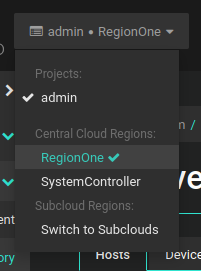
Go to Admin > Platform > Software Management and open the Deploy Orchestration tab.
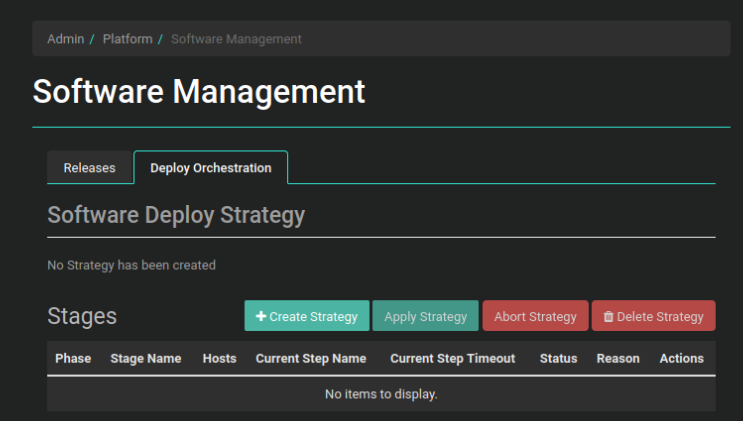
Select Create Strategy.
Create a Software Deploy strategy by specifying the settings for the parameters in the Create Strategy dialog box.
Note
Ensure the Delete checkbox is selected. If not, the deployment must be manually deleted via the CLI using the software deploy delete command after the strategy is completed. Failure to do so will prevent the subclouds’ software release sync state from being marked as out-of-sync, which will block the orchestration of the software deployment on the subclouds.
Click Create Software Deploy Strategy to confirm the strategy creation.
Note
To change the strategy settings, you must delete the strategy and create a new one.
Wait for the strategy status of the build phase to reach success.
Click on Apply Strategy to start deploying the software release.
Wait for the strategy to finish applying.
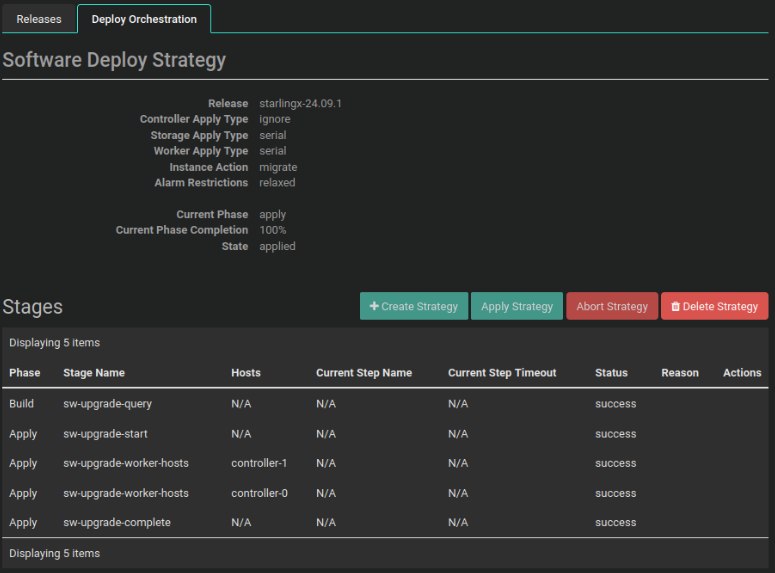
Once the new software release is applied, click Delete Strategy to delete the strategy.
Orchestrate the Deployment of a Software Release Across the Subclouds¶
After the System Controller has been successfully updated with a new major or patch software release; distributed software deployment orchestration can be initiated to bring the managed subclouds to the same software level as the System Controller. The subclouds must, however, be prestaged with the target software before orchestrated deployment can take place.
For more information on Prestaging Subcloud Orchestration see Orchestrate Subcloud Prestage Using the CLI.
Before orchestrating a major software release deployment across the subclouds, it is strongly recommended that a backup of each subcloud to be upgraded is taken. See Backup a Subcloud/Group of Subclouds using DCManager CLI for instructions.
Prerequisites
The following conditions must be met for the orchestrated software deployment across the subclouds to be successful.
All target subclouds are managed, online and healthy. The Kubernetes cluster on each subcloud is fully operational and there are no management affecting alarms.
Subcloud certificates are up-to-date or will not expire during the deployment of the new software release.
All target subclouds have been prestaged with the software release and the new container images required for that release. See Orchestrate Subcloud Prestage Using the CLI for instructions.
For the deployment of major software release, ensure that the controller-0 is the active controller on each subcloud.
The subclouds’ software sync status must be out of sync.
Note
If the target patch release to be deployed on the subcloud is not the latest patch release already deployed on the System Controller, the subcloud will need to be prestaged again before deploying any subsequent releases.
Procedure
Select the SystemController region.
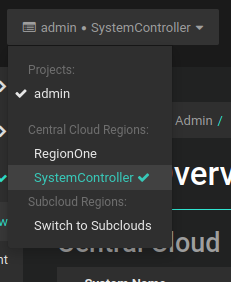
Select Distributed Cloud Admin > Orchestration.
On the Orchestration page, select the Strategy tab.
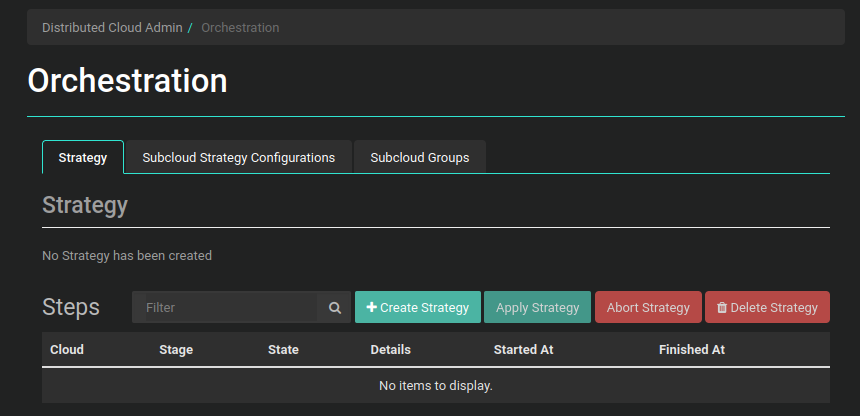
Create a new strategy.
On the Strategy tab, click Create Strategy. In the Create Strategy dialog box, select the Software Deploy strategy type and adjust the settings as needed.
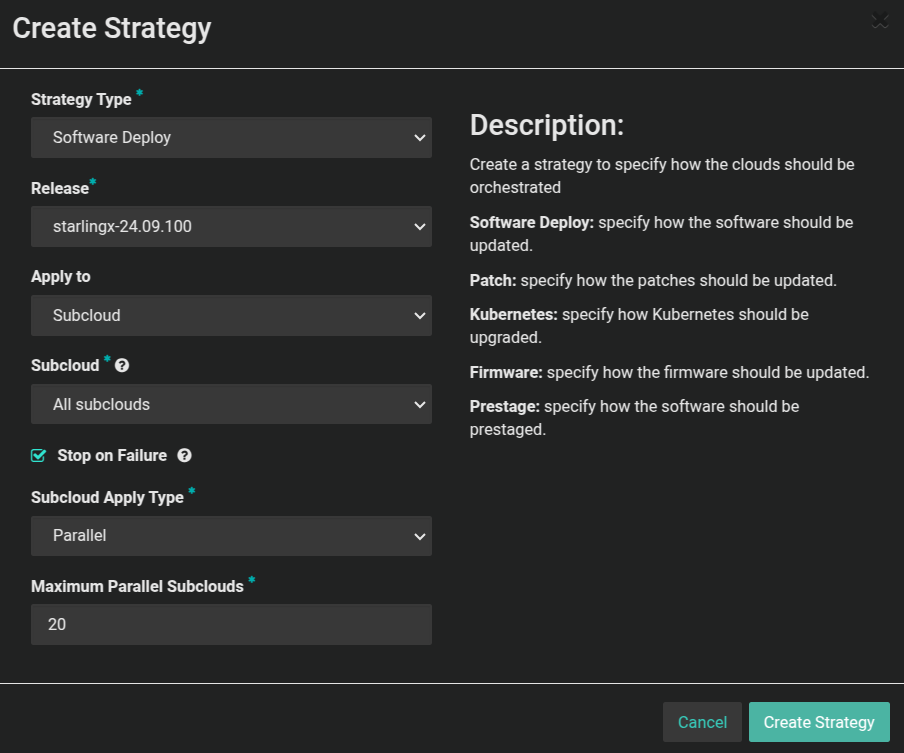
- Strategy Type
Software Deploy.
- Release
Release ID.
This option is available when Strategy Type is set to Sw-Deploy.
- Apply to
Subcloud or Subcloud Group.
- Subcloud
Select the subcloud name or All Subclouds.
- Subcloud Group
Select the subcloud group. Available only if you select the Apply to: Subcloud Group option.
- Stop on Failure
Default: True.
Determines whether update orchestration failure for a subcloud prevents application to subsequent subclouds.
- Subcloud Apply Type
Default: Parallel.
Parallel or Serial. Determines whether the subclouds are updated in parallel or serially.
- Maximum Parallel Subclouds
Default: 20.
Defines the maximum number of subclouds on which the software deployment can run in parallel. If the Apply to: Subcloud Group option is selected, it will use the
max_parallel_subcloudsvalue of the subcloud group instead.
Click Create Strategy to confirm the operation.
Click Apply Strategy to start applying the software release update to the subclouds.
As each subcloud is deployed, it moves through the following states:
- initial
The orchestration has not yet started.
- sw-deploy pre-check
Verify that the subcloud has no existing strategies, that it was pre-staged, and that the System Controller already has the specified release deployed.
- sw-deploy install license (only for major releases)
Installing release license.
- create VIM sw-deploy strategy
The strategy is being created in the subcloud.
- apply VIM sw-deploy strategy
The strategy is being applied in the subcloud.
- finish sw-deploy strategy
Updates that are no longer required are being deleted.
Updates that require committing are being committed.
- complete
The software release has been deployed successfully.
Once the strategy state changes to complete, click Delete Strategy to delete it.
Customize the Update Configuration for Distributed Cloud Update Orchestration¶
You can adjust how the nodes in each subcloud are updated.
About this task
The update strategy for Distributed Cloud Update Orchestration uses separate configuration settings to control how the nodes on a given system are updated. You can adjust the settings used by default for all subclouds, and you can create custom settings for individual subclouds.
You can change the configuration settings before or after creating an update strategy for Distributed Cloud update orchestration. The settings are maintained independently.
Procedure
Select the SystemController region.
Select Distributed Cloud Admin > Orchestration.
On the Orchestration page, select the Subcloud Strategy Configurations tab.

Take one of the following actions:
To edit the settings applicable to all subclouds by default, click Edit Configuration in the all clouds default row.
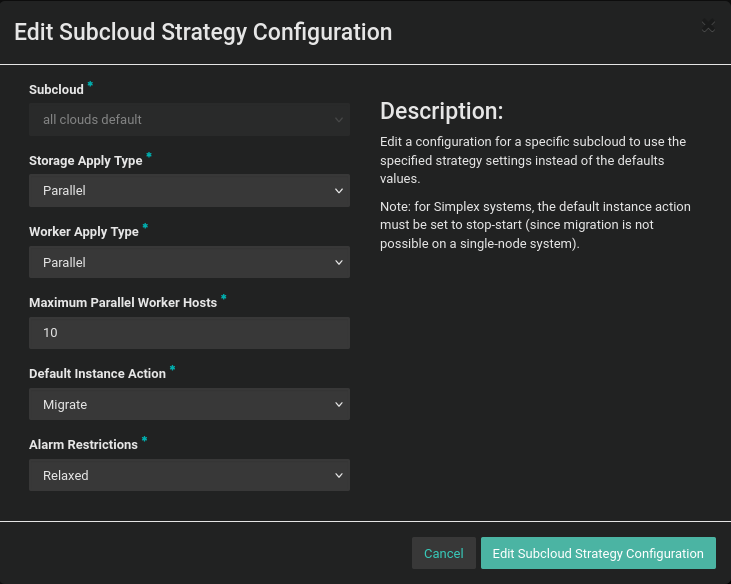
To save your changes, click Edit Subcloud Strategy Configurations.
To create custom settings for an individual subcloud, click Create New Subcloud Strategy Configurations.
In the Subcloud field, select the subcloud for the custom settings.
To save your configuration changes, click Create Subcloud Strategy Configurations. The new configuration is added to the list.

The following settings are available:
- Subcloud
This specifies the subcloud affected by the configuration. For the all clouds default configuration, this setting cannot be changed.
- Storage Apply Type
Parallel or Serial — determines whether storage nodes are patched in parallel or serially
- Worker Apply Type
Parallel or Serial — determines whether worker nodes are patched in parallel or serially
- Maximum Parallel Worker Hosts
This sets the maximum number of worker nodes that can be patched in parallel.
- Default Instance Action
Note
This parameter is only applicable to hosted application VMs with the stx-openstack application.
migrate or stop-start — determines whether hosted application VMs are migrated or stopped and restarted when a worker host is upgraded
- Alarm Restrictions
Relaxed or Strict — determines whether the orchestration is aborted for alarms that are not management-affecting.
Postrequisites
For information about creating and applying a patch strategy, see Software Release Deployment in Distributed Cloud Overview.
